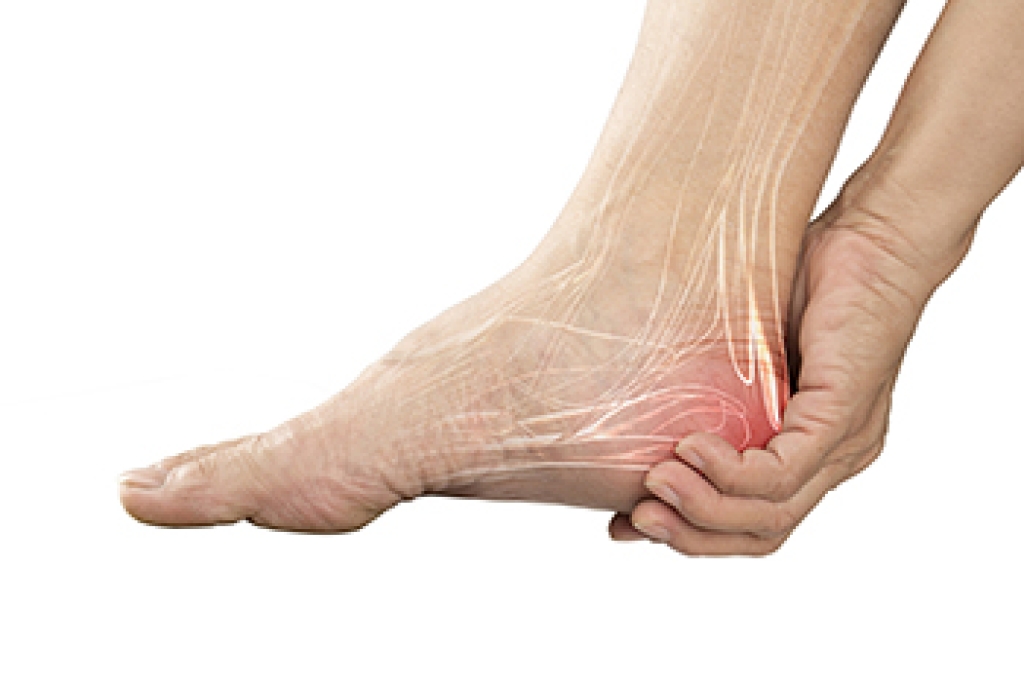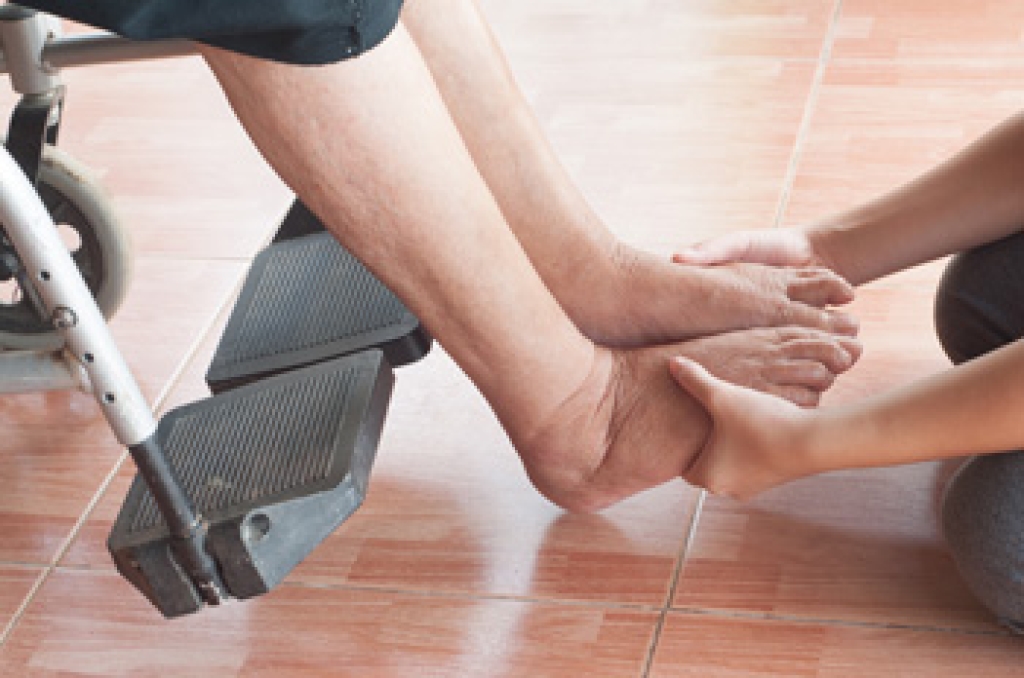Connect With Us
Blog
Blog
Risk Factors for Heel Pain

Heel pain felt along the bottom of the foot often results from inflammation of the plantar fascia, a thick band of tissue that supports the arch of the foot. Common causes include overuse, prolonged standing, repetitive impact from walking or running, and wearing unsupportive footwear. Risk factors include obesity, tight calf muscles, flat feet, high arches, and participation in high impact activities. Symptoms often involve sharp or aching pain in the heel, especially with the first steps in the morning, or after periods of rest. A podiatrist can help by diagnosing the underlying cause, recommending custom orthotics, stretching exercises, and footwear modifications to relieve pain. If you have persistent heel pain, it is suggested that you consult a podiatrist who can provide an accurate diagnosis and treatment.
Many people suffer from bouts of heel pain. For more information, contact Katie Besselman, DPM of Advanced Podiatry. Our doctor can provide the care you need to keep you pain-free and on your feet.
Causes of Heel Pain
Heel pain is often associated with plantar fasciitis. The plantar fascia is a band of tissues that extends along the bottom of the foot. A rip or tear in this ligament can cause inflammation of the tissue.
Achilles tendonitis is another cause of heel pain. Inflammation of the Achilles tendon will cause pain from fractures and muscle tearing. Lack of flexibility is also another symptom.
Heel spurs are another cause of pain. When the tissues of the plantar fascia undergo a great deal of stress, it can lead to ligament separation from the heel bone, causing heel spurs.
Why Might Heel Pain Occur?
- Wearing ill-fitting shoes
- Wearing non-supportive shoes
- Weight change
- Excessive running
Treatments
Heel pain should be treated as soon as possible for immediate results. Keeping your feet in a stress-free environment will help. If you suffer from Achilles tendonitis or plantar fasciitis, applying ice will reduce the swelling. Stretching before an exercise like running will help the muscles. Using all these tips will help make heel pain a condition of the past.
If you have any questions, please feel free to contact our office located in Saint Peters, MO . We offer the newest diagnostic and treatment technologies for all your foot care needs.
The Causes of Ticklish Feet

Ticklish feet are a common sensation that can make some people laugh uncontrollably, while others may find it uncomfortable. The sensitivity in the feet is due to the presence of approximately 8,000 nerve endings that respond to various stimuli. The sensation of tickling can be broken down into two types, which are known as knismesis and gargalesis. Knismesis refers to a light, often gentle touch that can cause itching or mild tickling sensations, while gargalesis is a more intense form of tickling that often results in laughter and can trigger an involuntary response. People vary in their sensitivity to tickling, as factors such as genetic makeup, nervous system sensitivity, and psychological aspects play a role. The feet are particularly sensitive due to their high concentration of nerve endings, which makes them more susceptible to ticklish sensations when touched or stimulated. Ticklish feet can be bothersome while having pedicures performed or getting foot massages. It may also indicate diabetes. If you have particularly sensitive feet, it is suggested that you consult a podiatrist who can educate you on this condition.
Foot Pain
Foot pain can be extremely painful and debilitating. If you have a foot pain, consult with Katie Besselman, DPM from Advanced Podiatry. Our doctor will assess your condition and provide you with quality foot and ankle treatment.
Causes
Foot pain is a very broad condition that could be caused by one or more ailments. The most common include:
- Bunions
- Hammertoes
- Plantar Fasciitis
- Bone Spurs
- Corns
- Tarsal Tunnel Syndrome
- Ingrown Toenails
- Arthritis (such as Gout, Rheumatoid, and Osteoarthritis)
- Flat Feet
- Injury (from stress fractures, broken toe, foot, ankle, Achilles tendon ruptures, and sprains)
- And more
Diagnosis
To figure out the cause of foot pain, podiatrists utilize several different methods. This can range from simple visual inspections and sensation tests to X-rays and MRI scans. Prior medical history, family medical history, and any recent physical traumatic events will all be taken into consideration for a proper diagnosis.
Treatment
Treatment depends upon the cause of the foot pain. Whether it is resting, staying off the foot, or having surgery; podiatrists have a number of treatment options available for foot pain.
If you have any questions, please feel free to contact our office located in Saint Peters, MO . We offer the newest diagnostic and treatment technologies for all your foot care needs.
Keeping Aging Feet Healthy With the Right Care

As people age, their feet often require extra attention to stay healthy and comfortable. Natural changes such as thinning skin, reduced cushioning in the heel, and decreased circulation can make the feet more vulnerable to injury or discomfort. Common issues include dry skin, thickened toenails, corns, and calluses that may become painful, if not properly managed. Arthritis and balance problems can also increase the risk of falls and limit mobility. Choosing supportive shoes with good cushioning and non-slip soles helps protect aging feet during daily activities. Regularly checking for cuts, sores, or changes in shape is important, especially for those with diabetes. Gentle stretching or low impact exercises can keep the feet flexible and strong. If you are experiencing foot pain or difficulty caring for your feet as you get older, it is suggested that you see a podiatrist for personalized guidance.
If you need your feet checked, contact Katie Besselman, DPM of Advanced Podiatry. Our doctor will attend to all of your foot and ankle needs and provide you with quality treatment.
Geriatrics and Podiatry
When people age, some common issues that may occur are bone density loss, dry skin, poor circulation, and rough brittle nails. These issues may also affect your foot health if the necessary steps are not taken to alleviate the problems.
It is important to take care of your feet because feet that are injured or diseased can affect your overall health. Having painful feet hinders your ability to do daily activities or may decrease your willingness to do the things that you need to do.
Visiting Your Geriatrician
As we age, health problems become more likely, so it is essential to visit your doctor for check-ups to ensure that you are doing the best you can to take care of your health. It is recommended to check your feet frequently for any possible cuts, bruises, swelling, corns or any other irregularities.
Taking Care of Elderly Feet
Cracked or dry feet can be treated by applying moisturizer often. It is also important not to wear old socks because the older the sock is, the higher the possibility there will be that there is bacteria there. Wear fresh socks and make sure they fit properly.
Proper foot health means that you can have a more active lifestyle and you will not be bogged down by pain. Foot health also leads to good circulation, which is paramount for overall health.
If you have any questions, please feel free to contact our office located in Saint Peters, MO . We offer the newest diagnostic and treatment technologies for all your foot care needs.
Treatment Options for Clubfoot

Clubfoot is a congenital condition that causes a baby’s foot to turn inward or downward, affecting one or both feet. The heel and calf on the affected side are often smaller, and, in severe cases, the foot may appear twisted and almost upside down. Although clubfoot is not painful for babies, it prevents normal walking, if left untreated. Genetics appears to play a role in this condition, as risk increases when there is a family history. Other contributing factors include smoking during pregnancy or reduced amniotic fluid in the womb. A podiatrist can diagnose clubfoot soon after birth, and, in some cases, it may even be detected on prenatal imaging. Treatment often begins within weeks of delivery. It may involve gentle stretching with casting and a gradual repositioning of the foot. Surgery is considered when the deformity is severe. If your baby has a clubfoot deformity, it is suggested that you promptly schedule an appointment with a podiatrist, including this type of doctor on your healthcare team.
Congenital foot problems require immediate attention to avoid future complications. If you have any concerns, contact Katie Besselman, DPM of Advanced Podiatry. Our doctor can provide the care you need to keep you pain-free and on your feet.
Congenital foot problems are deformities affecting the feet, toes, and/or ankles that children are born with. Some of these conditions have a genetic cause while others just happen. Some specific foot ailments that children may be born with include clubfeet, polydactyly/macrodactyly, and cleft foot. There are several other foot anomalies that can occur congenitally. What all of these conditions have in common is that a child may experience difficulty walking or performing everyday activities, as well as trouble finding footwear that fits their foot deformity. Some of these conditions are more serious than others. Consulting with a podiatrist as early as possible will help in properly diagnosing a child’s foot condition while getting the necessary treatment underway.
What are Causes of Congenital Foot Problem?
A congenital foot problem is one that happens to a child at birth. These conditions can be caused by a genetic predisposition, developmental or positional abnormalities during gestation, or with no known cause.
What are Symptoms of Congenital Foot Problems?
Symptoms vary by the congenital condition. Symptoms may consist of the following:
- Clubfoot, where tendons are shortened, bones are shaped differently, and the Achilles tendon is tight, causing the foot to point in and down. It is also possible for the soles of the feet to face each other.
- Polydactyly, which usually consists of a nubbin or small lump of tissue without a bone, a toe that is partially formed but has no joints, or an extra toe.
- Vertical talus, where the talus bone forms in the wrong position causing other bones in the foot to line up improperly, the front of the foot to point up, and the bottom of the foot to stiffen, with no arch, and to curve out.
- Tarsal coalition, when there is an abnormal connection of two or more bones in the foot leading to severe, rigid flatfoot.
- Cleft foot, where there are missing toes, a V-shaped cleft, and other anatomical differences.
- Macrodactyly, when the toes are abnormally large due to overgrowth of the underlying bone or soft tissue.
Treatment and Prevention
While there is nothing one can do to prevent congenital foot problems, raising awareness and receiving neonatal screenings are important. Early detection by taking your child to a podiatrist leads to the best outcome possible.
If you have any questions, please feel free to contact our office located in Saint Peters, MO . We offer the newest diagnostic and treatment technologies for all your foot care needs.
Blog Archives
- 2025
- 2024
- 2023




